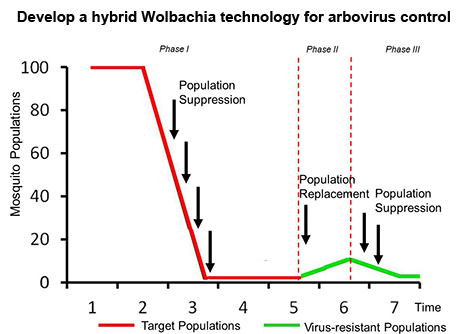The ability of Wolbachia to induce CI in its host has led to the proposal of two major strategies to control mosquitoes and the diseases they transmit. One is referred to as population suppression and entails the release of male mosquitoes infected with Wolbachia, resulting in sterile matings and a reduction in the mosquito population. This strategy is similar to the sterile insect technique (SIT) and, by analogy, is also called the “incompatible insect technique” (IIT).

Figure from Kaur, et al. 2021. Cell Host & Microbe
The second strategy, known as population replacement, would use Wolbachia to spread Pathogen blocking traits into the population. Because of the advantage in reproduction that it confers on infected females as compared to their uninfected counterparts, Wolbachia is able to invade a target population, even given the limited level of fitness cost it also confers. This invasion, together with Wolbachia-mediated pathogen interference, would eventually modify the population and reduce its ability to transmit diseases to humans.
The above techniques can be intergarted togather to develop a hybrid version for maximizing the efficiency of disease control. In this hybrid technology, Wolbahcia-infected males are released to induce sterility for population suppression, followed by seeding with Wolbachia-infected virus-resistant females to trigger population replacement. Finally, male mosquitoes carrying the 2nd Wolbachia strain are released to maintain a low mosquito population that will not support virus circulation.

The hybrid Wolbachia technology to reduce both mosquito biting and capacity of mosquito to transmit diseases (Xi and Joshi, 2016. Genetic Control of Malaria and Dengue Using Wolbachia).








 Location:
Location:








